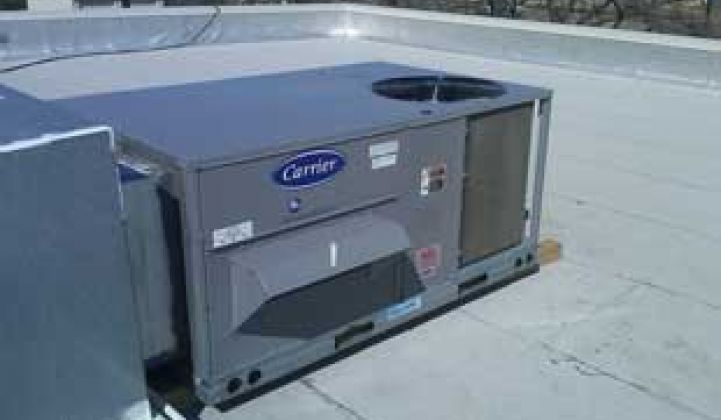Regen Energy is teaming up with Carrier to bring its demand management solution to help small and medium-sized businesses manage energy use.
Carrier has been busy lately stacking up partnerships with startups to integrate its air conditioners with energy management systems. After inking agreements with EnergyHub and ThinkEco on the residential side, Carrier is now turning its attention to the small and medium commercial market.
Carrier, a unit of United Technologies Corp. (NYSE: UTX), is one of the biggest names in heating, cooling and refrigeration. It will resell Regen’s Swarm energy management system to work with its commercial rooftop units.
The partnership is Regen Energy’s largest partner to-date, but it already counts plenty of household names as customers, including Sears, Kmart and Dave & Busters.
For the bulk of small and medium commercial, “they have no form of intelligent automation,” said Tim Angus, president and CEO of Regen Energy. “There are lots of incentives for demand response, but you have this challenge: how do you do this when there’s no automation?”
The Swarm controllers offer a solution that is about one-third the cost of a traditional building management system, said Angus, who spent nearly a decade at Johnson Controls. The cost for a big-box store, for example, might be around $35,000. In California, where the bulk of Regen’s business has been so far, major utilities are offering incentives that can cover some or all of the total cost of the system.
The devices are installed on every rooftop unit, which might be about twenty for a big-box store. For the first week or two, the technology just collects information from the AC units. The controllers communicate to each other over a ZigBee network about every 30 seconds to make decisions on how to optimize the load in a way that’s cooperative between all the different units. “We can essentially make them play together more effectively,” said Angus. That information is then brought back to Regen’s platform over cellular backhaul.
Currently, most of the controllers are going on rooftop ACs, although Angus said they are also looking at EV chargers, forklift chargers, irrigation pumps, lighting and refrigeration.
The payback on just rooftop HVAC systems, however, is about two years with no other incentives. Angus said that customers have purchased about 8,000 to 10,000 of the smart systems, and the company is starting to grow out of California as customers roll out the technology to more of their portfolio. Dave & Busters, for example, is doing an additional 75 locations across PJM and Texas after first working with Regen in California.
“We’re not really competing against building automation,” said Angus, who noted that about 40 percent of their customers have a BMS. Instead, the system can offer demand management and demand response on top of the BMS, which is often more about comfort than energy management. Regen is also working with major demand response providers to squeeze additional megawatts out of AC systems. In most cases, Angus said, his company can get about a five-fold increase in load under control.
The Swarm controllers offer about a 15 percent to 30 percent savings just by smoothing out peaks. That savings offers about a two-year payback. From there, the system can offer additional load shedding if a customer wants to enroll in demand response, which can make the payback even quicker. The temperature inside the building is kept within about 2 degrees of the chosen set point.
The Toronto-based startup works with many retail outlets, but it is also working with school districts, theaters, bowling alleys and just about any type of building with multiple rooftop or stacked AC units.
Regen seems happy to partner with everyone, including large building management firms, demand response providers, and now equipment manufacturers. With a huge untapped market in small and medium commercial that only a few other startups (EnTouch, SCL Elements, Retroficiency) are serving, Angus doesn’t see much competition. And even if competition comes, for now, this underserved market has space for multiple players.
“The single biggest competitor is [companies choosing] to do nothing,” said Angus. “It’s just a matter of education.”



